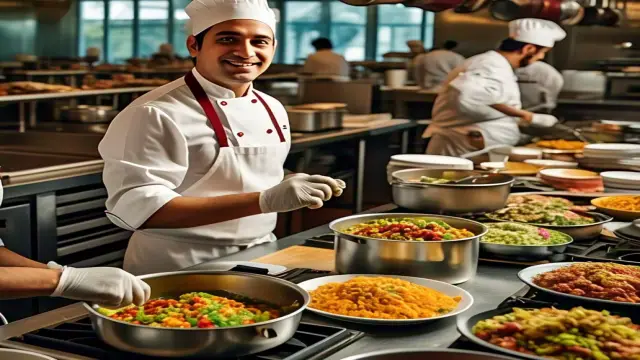Food is more than just fuel for the body—it’s a vital part of culture, tradition, and identity. In Ghana, food plays a central role in customs and daily life. What one group considers a delicacy, another might not even regard as food. As a caterer, understanding these differences is key to satisfying your customers and growing your business. This guide explores the role of food habits, their impact on food choices, and how you can use this knowledge to succeed in the catering industry.
What Are Food Habits?
Food habits refer to the way people select, cook, serve, and eat the foods available to them. These habits are shaped by culture, tradition, and personal experiences.
For example:
- In Ghana, maize is used differently across regions. The Ewes make akpele, the Gas prepare komi, the Efutus cook etsew, the Fantes enjoy ntew, and the Ahantas savor fomfom. Each dish is paired with unique soups or sauces, reflecting local tastes and traditions.
- Eating methods also vary. Some people use their hands, others prefer cutlery, and some use chopsticks. These practices are all part of food habits.
Understanding these habits helps you cater to diverse preferences and create meals that resonate with your customers.
Factors Influencing Food Habits
Food habits are shaped by several factors:
- Culture and Tradition
Cultural practices heavily influence what people eat and how they eat it. For instance, certain foods are reserved for festivals or special occasions. - Geography
Local availability of ingredients affects food choices. Coastal communities might favor seafood, while inland areas rely more on grains and vegetables. - Economic Status
Income levels impact food choices. A rise in economic status often leads to changes in eating habits, sometimes for better or worse. - Exposure to New Foods
People develop preferences based on what they’re exposed to. Sweet flavors are universally liked, but tastes for spicy, salty, or bitter foods are often acquired over time. - Nutrition Education
Learning about the health benefits of certain foods can shape long-term eating habits.
How Food Habits Affect Food Choices
Food habits directly influence what people choose to eat. Here’s how:
- Familiarity
People tend to prefer foods they grew up eating. A caterer who offers familiar dishes is more likely to attract customers. - Health Considerations
Habits formed through nutrition education lead to healthier food choices. For example, someone who learns about the benefits of vegetables might include more greens in their diet. - Economic Changes
When someone’s financial situation improves, they might switch to more expensive or exotic foods. Conversely, economic downturns can lead to simpler, more affordable meals. - Cultural Identity
Food is a way to connect with one’s roots. Offering traditional dishes can evoke nostalgia and comfort for your customers.
Food Habits and the Catering Industry
As a caterer, understanding your customers’ food habits is crucial for success. Here’s why:
- Customer Preferences
People are more likely to buy foods they know and enjoy. Offering familiar dishes with appetite appeal ensures repeat business. - Timing and Presentation
Consider when and how your customers prefer to eat. Some might enjoy hearty breakfasts, while others prefer light dinners. Presentation also matters—people eat with their eyes first. - Cultural Sensitivity
Respecting your customers’ food habits shows that you value their culture and traditions. This builds trust and loyalty. - Innovation Within Limits
While it’s important to stick to familiar flavors, don’t be afraid to introduce subtle twists. For example, you could add a modern touch to a traditional dish without losing its essence.
The Role of Exposure in Food Acceptance
Exposure plays a big role in shaping food habits. The more someone is exposed to a food, the more likely they are to accept it. Here’s how you can use this to your advantage:
- Introduce New Flavors Gradually
If you want to introduce a new dish, pair it with familiar ingredients. For example, serve a spicy stew with a well-known staple like rice or fufu. - Encourage Sampling
Offer small samples of new dishes to encourage customers to try them. This reduces the fear of the unknown. - Educate Your Customers
Share the story behind a dish or its health benefits. This can pique curiosity and make people more willing to try it.
Practical Tips for Caterers
- Research Your Market
Understand the cultural and regional preferences of your target audience. - Offer Variety
Include a mix of traditional and modern dishes to cater to different tastes. - Focus on Quality
Use fresh, high-quality ingredients to enhance flavor and appeal. - Adapt to Trends
Stay updated on food trends, such as the growing demand for healthier or plant-based options. - Seek Feedback
Regularly ask customers for feedback to improve your menu and service.
Overview
- Food habits are deeply rooted in culture, tradition, and personal experiences.
- Understanding these habits helps you create meals that resonate with your customers.
- Exposure and education play a key role in shaping food preferences.
- As a caterer, respecting and adapting to your customers’ food habits is essential for success.
Final Thoughts
Food is a powerful way to connect with people and celebrate diversity. By understanding the role of food habits in Ghanaian culture, you can create meals that not only nourish the body but also delight the soul. Whether you’re serving a traditional dish or experimenting with new flavors, always keep your customers’ preferences at the heart of your catering business.

